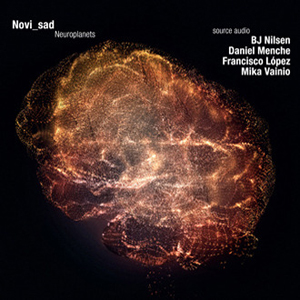Novi_sad, "Neuroplanets"
 Thanasis Kaproulias has been quietly building an impressive repertoire of conceptual sound art releases for the past few years. Neuroplanets may perhaps be the most varied and complex release yet, by not only utilizing source material from four titans of the field (BJ Nilsen, Daniel Menche, Francisco Lopez and Mika Vainio) but also applying data from neurological and astronomical research into his compositions. The end product is something that sounds more like a collaboration where the original artists’ sound is measurable, but also Kaproulias' reworking as well.
Thanasis Kaproulias has been quietly building an impressive repertoire of conceptual sound art releases for the past few years. Neuroplanets may perhaps be the most varied and complex release yet, by not only utilizing source material from four titans of the field (BJ Nilsen, Daniel Menche, Francisco Lopez and Mika Vainio) but also applying data from neurological and astronomical research into his compositions. The end product is something that sounds more like a collaboration where the original artists’ sound is measurable, but also Kaproulias' reworking as well.
Unlike his last release for the label, Inhumane Humans, Novi_sad does not work with as much overt noise and dissonance, although those things do crop up tastefully throughout.The first piece allows BJ Nilsen's careful, understated touch to sound to be prevalent in the form of buzzing and ghostly passages of sound drifting through, occasionally bringing along the hint of a melody that slowly dissipates into the ether.Eventually the piece builds to a dense and heavy blast of digital noise, but used as a tasteful climax rather than an overused stylistic choice.
In more of a departure, the material provided by Daniel Menche sticks to the high end of the spectrum, and also has the sound of being recorded in a massive, abandoned warehouse.Considering Menche's work is so often of a very organic nature, and heavy on the bass, it is a different recording than I was expecting.The piece (meshed with data of plasma waves from NASA and patterns of music agnosia) ends up with a denser, heavier sound that is more of a product of its spaciousness rather than the actual abrasiveness of the sound, as counterintuitive as that may sound.
Kaproulias' work with material from Francisco Lopez demonstrates the Spanish composer’s touch early on, with near silence and subsonic rumbles to slowly build the work from almost nothing.However, the collaborative element becomes clear when metallic, grinding rhythmic scatters and noises appear, locked into some sort of ersatz rhythm that becomes sharper as the piece clicks on.By the end, it sounds like a recording from within a factory, with all associated noise and distortion.
The final composition is built on recordings from Pan Sonic's Mika Vainio in a work dense with digital noise and what sounds like bits of a malfunctioning guitar cable.There is a heavy electronic sheen to everything, and with the use of guitar-resembling sounds it fits with Vainio's recent works.Throughout this piece there are rising and falling ultra sonic blaststhat are balanced by more peaceful, shimmering sounds, but ending the piece in a rather painful outburst due to the processing of Kaproulias.
How exactly the use of neurological and astronomical data shaped these four compositions is not at all clear.Being that it is not too difficult to hear the source material Kaproulias used from other artists, my curiosity of course was to how the processing was handled.Knowing the answer to that is not a necessity, however, and Neuroplanets is a strong piece of occasionally harsh sound exploration even without its conceptual trappings and appearances by other artists.Novi_sad's work sounds even more singular and self assured than before, with him firmly establishing himself amongst the most noteworthy artists in the field.
samples:
 



